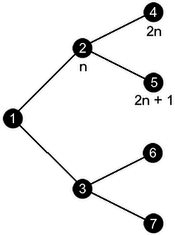Family Numbering Scheme
It is helpful to use a numbering scheme when referring to the ancestral families in your family tree. You may wish to consider the following scheme if you plan to manually number your families with User Reference Numbers (REFN) or Custom Fact tags described under Family Page References
Referring to a family by the names of the spouses is problematic. Their names might change as new information about them is discovered. A number is also easier to reference in a filing scheme for paper documents or index cards, as well as for computer files and Internet web pages.
Here is a method for numbering families (not individuals) for your direct-line ancestry. First, notice that an ancestor or pedigree chart is actually a "binary tree," meaning that each node, or family, in the tree always has exactly two ancestor nodes. Each of the two nodes can therefore be assigned a unique number. This includes even the "missing" nodes, or families that you have yet to discover.
Start with your parent's family, of which you are a child. This is family 1. Your father's family is family number 2 and your mother's family is family number 3. Now move to your father's family. His father's family is number 4 and his mother's family is number 5. Now move back to your mother's family. Her father's family is number 6 and her mother's family is number 7. A pedigree chart would appears as follows:

The pattern that emerges is, for any given family n, the paternal parents are numbered 2n and the maternal parents are numbered 2n + 1. This is the idea behind the Ahnentafel numbering scheme. For node 3 for example, the paternal family is 2*3=6 and the maternal family is 2*3+1=7. This formula applies to any node. At node 144, one of your paternal sixth great-grandparents, the paternal family is number 2*144=288 and the maternal family is number 2*144+1=289. Even if you have not discovered your seventh great-grandparents, numbers are still reserved for their families.
Many genealogy software programs automatically number your families. However, the numbers assigned by the program may change as you add or remove families. This can throw off your filing system. Instead you can manually number each of your ancestral families according to the above scheme. Generally, your genealogy software program will not automatically change the numbers you enter yourself. You can then refer to a particular ancestral family and leave no doubt as to which you are referring. In your research, when you discover a child of one of your ancestors, you can include the family number in your notebook.
For consistency, you may wish to make the numbers five digits long, like 00289. If you also trace your spouse's ancestors, you can add a separate prefix to tell them apart, like B00289 for your family and M00289 for your spouse's family.
Unfortunately this numbering scheme does not account for your descendants, since each family can have fewer, or more, than two children. It also does not account for non-direct line ancestors, who you wish to reference by number. For these families I assign an arbitrary number greater than any possible direct-line family. These numbers are sequential, starting at 50000. The maximum number of families in a binary tree is 2k - 1, where k is the number of generations. So 15 generations would account for 215 - 1 = 32,767 families, that is, 2 to the 15th power, minus 1.